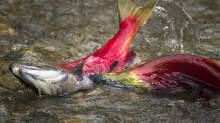Record salmon run draws bald eagles to BC river shores
If the circle of life is a play, Harrison Bay in Harrison Mills, Canada's westernmost province British Columbia (BC), is its stage and the Fraser Valley Bald Eagle Festival which kicked off Thursday is the season premier.

Each fall thousands of bald eagles gather on the shores of the bay, on the Harrison River, which winds amongst the steep walls of the Fraser Valley, about 100 kilometers east of Vancouver.
Celebrating its 15th anniversary this year, the Bald Eagle Festival is expected to draw between 1,000 and 3,000 people to the shores of the Harrison River each fall to witness the unique spectacle.
With four viewing sites, it offers the public a chance to witness the rare natural phenomenon up close.
Organized by the Fraser Valley Bald Eagle Society, the festival started in 1995 to bring awareness to the bay's rich and vibrant ecosystem.
Festival organizer and president of the Fraser Valley Bald Eagle Society Jo Anne Chadwick told Xinhua that she hopes the impressive spectacle helps the public become aware of the fragile circle of life the birds are a part of.
Alongside eagle viewing sites, the festival also offers guided educational hikes, lectures, do-it-yourself gardening and wildlife workshops, and events for children.
"This is the part that resonates with the people. They may hear about sustainability, about recycling, and protecting the environment, but what does it really mean?" she said.
"When you come out to this area, which is one of the most beautiful places we have in BC, and you see thousands of eagles, and salmon, and deer, and bear and seal, you become connected to it, and when you are connected to something, you care about it."
This year's festival started with a welcome song from members of the Chehalis First Nation, whose traditional territory the bay is part of.
For the First Nations people of British Columbia, the eagle is revered as a powerful spirit, and creator of life.
The Orphaned Wildlife Rehabilitation Society, a rehabilitation center for birds of prey, also released a rehabilitated eagle that had been found one year ago injured at the Vancouver dump back into the wild -- a reminder for onlookers this weekend of the power, and fragility of the circle of life.
The birds, some weighing up to 14 pounds, have gathered to feast on the carcasses of salmon that died after making the long journey upstream from the Pacific Ocean to spawn.
During a dryspell, the birds could go up to a week without eating, but this time of year, the birds eat between one and two pounds of salmon per day, stocking up here on fatty fish to brave the winter cold before returning to their nests in February and March for mating season.
It's a rare sight to see, even on the most remote parts of the wild west coast of British Columbia. Bald eagles, the magnificent birds white-capped of prey, do not make public appearances very often, let alone in the thousands.
This year, thanks to one of the largest salmon runs in southern British Columbia's history, which numbered over 35 million and lower salmon runs in the north, organizers are expecting one of the largest turnouts of birds and spectators yet.
"This is a record number of birds this year,"said David Hancock, a biologist, conservationist, and author who has spent most of his life studying wildlife on the west coast of British Columbia. Hancock recently published a book about bald eagles on the Pacific West Coast.
Hovering over the bloated white carcasses littering the rocky shoreline, and over 2,500 bald eagles have already gathered in the bay, which covers an area of less than two kilometers squared.
"We don't normally get large numbers of eagles here until the freeze up which is usually late November, December, and January. But this year almost no salmon on the northern river, so the eagles started to show up here almost a month early," he said.
With about 150 more arriving each day, the number is expected to surpass 5,000 by December.
"In the whole world this is the largest, most dense concentration of predators anywhere. It doesn't matter whether you're talking about the biomass of lions or hyenas in Africa, the vultures, there are more eagles in a square mile up here than in anywhere else in the world," said Hancock.
"It's a pretty impressive biological wonder," he said.
 0
0 







Go to Forum >>0 Comments